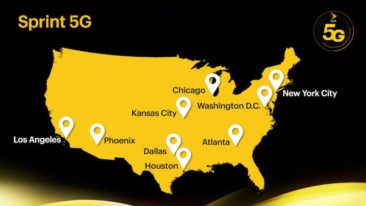Sprint, last week, rolled out its initial 5G services in four American markets, namely Kansas City, Houston, Dallas-Fort Worth, and Atlanta.
Sprint’s first 5G rollout comes with two recently-launched smartphones, i.e., the HTC 5G Hub and the LG v50 ThinQ 5G, which are now up for grabs at your nearest Sprint store.

In his dialogue addressing the media, Sprint CEO Michel Combes conveyed his happiness on the launch of Sprint’s “true mobile 5G” services with the largest initial network coverage in the US market.
Earlier, Sprint officials have taken a jab at Verizon and AT&T for launching what they consider sham 5G services that are limited to just a small pocket of coverage.
In their next rollout, Sprint is expected to cover 5 more US cities by the end of this month, extending the availability of their 5G services to Washington DC, Phoenix, New York City, Los Angeles, and Chicago.
With all of its 5G services in the 9 US markets, Sprint expects to cover nearly 11.5mn people and around 2,180 square miles. During the latter half of this year, Sprint will roll out its 5G service offerings for the Samsung Galaxy S10 smartphone.
Sprint is providing 5G at no extra cost as part of its Unlimited Premium Package.
For its 5G coverage, Sprint is using Ericsson’s Massive MIMO Radios, which deploys 64 transmitters/64 receivers. Also, the radios are powered by the 2.5 GHz mid-band spectrum and support the split-mode, which helps Sprint deliver the 5F NR service as well as LTE Advanced services, simultaneously.
Sprint has deployed the radios on their existing 4G cell sites, which helps provide an almost identical footprint for the coverage of both 5G NR as well as 2.5 GHz LTE.

In this regard, Sprint’s CTO John Saw said that their 5G deployment has gone on smooth enough to turn up more coverage along with the POPs covered than they originally expected.
For building up their 5G network, Sprint has upgraded its current towers using the Massive MIMO technology, which helps support 5G and LTE simultaneously using the same hardware.
He said, “We don’t have to build small cells with the initial launch.” Also, Sprint faced no jurisdictional challenges in the deployment of its first 5G network.
Sprint has onboard an extremely potent 2.5 GHz mid-band spectrum, which helps deploy the split-mode technology to good effect.
On the other hand, several carriers, including Verizon, have long been talking about the deployment of dynamic spectrum sharing, a new concept that helps a carrier in using the same spectrum band for 5G and LTE at the same time.
“We have a lot of mid-band spectrum at 2.5 GHz,” said Saw. The carrier has done way better than the alleged dynamic spectrum sharing concept. “We are dedicating spectrum to LTE and dedicating separate spectrum for 5G, no spectrum sharing in our case,” he said.
To deliver 5G coverage, Sprint has used up to 40-60 MHz for 5G NR and up to 120 MHz: 60 MHz at the LTE side at launch.
At a demo of its initial 5G service offerings in Dallas, early speed tests recorded 100 Mbps on the low-end and a peak speed of up to 1 Gbps. The carrier claimed that its 5G speeds are roughly 5 times the LTE speeds.
What is ENDC?
The newly-launched 5G network by Sprint is driven by a new technology known as the E-UTRAN New Radio-Dual Connectivity (ENDC), which helps devices in accessing both 5G and LTE at once on the same spectrum band. On Sprint’s 5G coverage, it will be Band 41 on the 2.5 GHz spectrum.
Saw said that ENDC is a dual connectivity technology where we can connect the traffic from 5G NR and LTE together on a smartphone.
Dual connectivity is working on Sprint’s network and their supported smartphones, which is helping users in benefiting from the capacity of 5G as well as LTE network.
“I believe we are one of the first to have dual connectivity working simultaneously across LTE advanced and 5G NR,” Shaw claimed.

